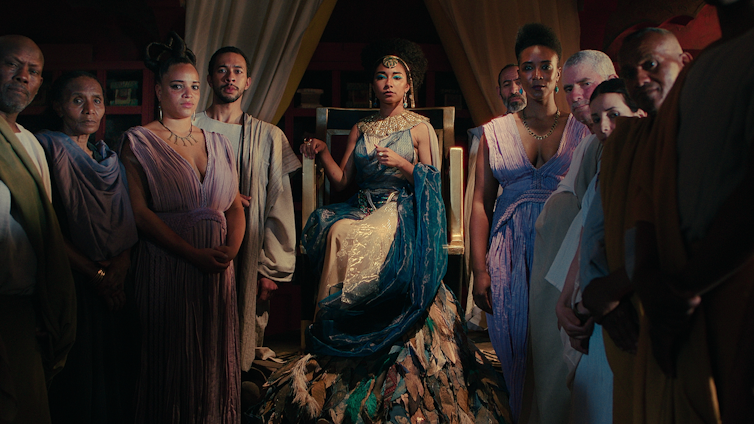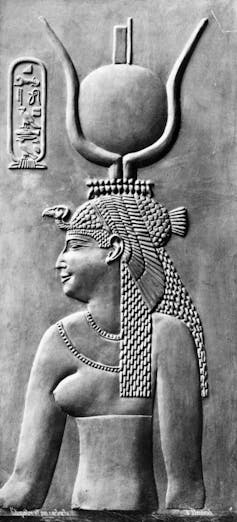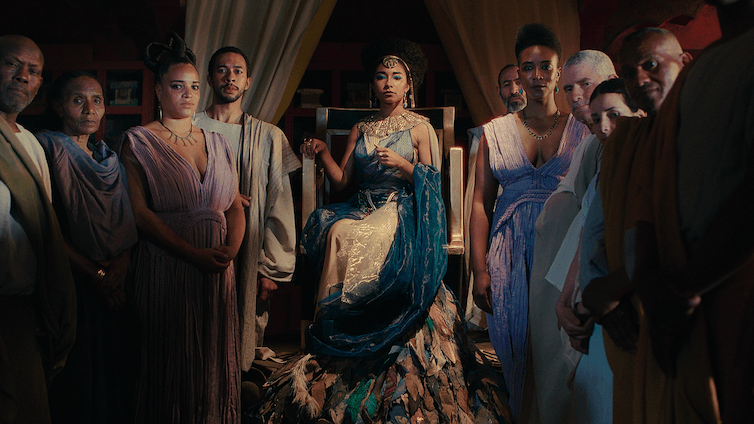
Cleopatra, queen of Egypt in the years 51-30 BC, is back in the news thanks to a controversial docudrama series on Netflix called Queen Cleopatra. Much debate has raged about her ethnicity. The queen was of Greek ancestry. In the Netflix series she’s played by a black actress. The fuss has provided an opportunity to look at her role in history and how she has been portrayed over time. Historian Toby Wilkinson is an Egyptologist and author of the award-winning book The Rise and Fall of Ancient Egypt: the History of a Civilisation from 3000 BC to Cleopatra. We asked him to shed some light on the past.
Who was Cleopatra and why is she so important?
In a very real sense, the reign of Cleopatra marks the final flourishing of ancient Egyptian culture.
Cleopatra – or Cleopatra VII to be precise: there were six earlier queens with the same name – was the last monarch of the Ptolemaic dynasty, a family of Macedonian Greek origin which ruled Egypt from the death of Alexander the Great in 323 BC until the country’s conquest and occupation by Octavian (later Emperor Augustus) in 30 BC.
During her reign of 21 years, at a time when other states in the eastern Mediterranean were being assimilated by the growing power of Rome, Cleopatra managed to preserve Egyptian independence through her astute diplomacy, strategic leadership and personal charisma. She is important because of her position in history – she is the individual who connects the Hellenistic Age of Alexander’s successors and the Roman Empire that followed it – and her legendary status since her death. When Cleopatra died, so did ancient Egyptian civilisation as a vibrant, living culture.
What do you make of the controversy over her ethnicity?
It tells us more about the preoccupations of our own time than about what was considered important in Cleopatra’s age. According to my knowledge of ancient Egyptian custom, skin colour was much less important than culture: if you lived like an Egyptian, adopting Egyptian cultural practices, then you were considered an Egyptian, whatever your ethnic background. There is no evidence that Cleopatra’s ethnicity was a matter of debate or interest during her own lifetime. She came from a long line of Greek-speaking kings, but her family had lived in Egypt for 300 years.
There is some doubt about the identity of Cleopatra’s mother. But centuries of royal precedent suggest she too would have been of Macedonian Greek descent.
Because of Cleopatra’s remarkable achievements during her lifetime and her lasting reputation down the ages, it is understandable that different groups want to claim her as their own. Cleopatra belongs to us all.
Why do you think her looks have been foregrounded?
If we look at the images of Cleopatra created during her own lifetime – in statuary, on temple walls, and on coins – she does not necessarily conform to modern ideals of beauty.

For example, she is often depicted with a long, aquiline nose and a pointed chin. But because Cleopatra evidently charmed two of the strongest military leaders of her day – the Romans Julius Caesar and Mark Antony – we project onto her our own cultural preconceptions about female influence, and assume she must have been physically attractive.
However, beauty is in the eye of the beholder, and history teaches us that power is a strong aphrodisiac. Her attractiveness to Caesar and Antony would have stemmed as much from her position of power, ruling over the wealthiest country in the Mediterranean, as from any personal qualities. Whether Cleopatra was “beautiful” or not in modern terms, she was an accomplished ruler and skilful politician, and her contemporaries clearly recognised her abilities.
What about her brain? What did she achieve in her time?
Cleopatra was intelligent, shrewd and strategic. She was a woman ruler in a world dominated by strong men. She forcefully asserted her right to rule, dispensing with her two brothers when they undermined or tried to thwart her objectives. Both ended up dead.
Her strategic liaisons with Caesar and then Antony were carefully calculated to secure her own position and her country’s autonomy. Her diplomatic skills enabled Egyptian independence when other states were falling to the power of Rome.

As a native Greek speaker, she was also the first of her dynasty to learn to speak Egyptian, so that she could communicate with her subjects in their own language. This was highly unusual at the time, given the differences and difficulties of the language. It marks Cleopatra as a progressive thinker and able linguist.
Her leadership skills also enabled her to avert famine in Egypt when other lands in the eastern Mediterranean suffered from starvation. Last but not least, she was comfortable operating across cultures: she promoted ancient Egyptian civilisation, founding new temples and honouring the traditional deities, while also maintaining Egypt’s position as the leading nation of the Greek-speaking Hellenistic world.
Why do you think she still fascinates people?
Even in her own time, Cleopatra was a source of fascination – as a woman ruler in a man’s world. The Romans found her exotic, intriguing and controversial; and the writings of Roman historians and commentators ensured Cleopatra’s posthumous reputation. Her entanglement with Rome, especially her infamous love affairs with Caesar and Antony, scandalised contemporary Roman society and have fascinated subsequent generations.
The exact nature of these relationships – were they based on true love or political necessity, and what the power dynamic between Cleopatra and her lovers was – has inspired writers throughout history, from British playwright William Shakespeare to Hollywood.
Today, her example of female empowerment and independence of thought resonates with contemporary concerns. Although Cleopatra’s name is famous, we actually know very little about her real character. This allows every age to project its hopes, fears and aspirations onto her.
Queen Cleopatra streams on Netflix from 10 May
***
Toby Wilkinson, Fellow of Clare College, University of Cambridge
This article is republished from The Conversation under a Creative Commons license.





